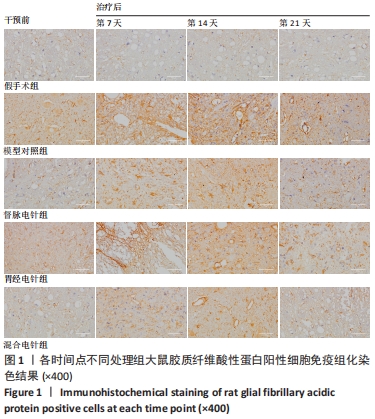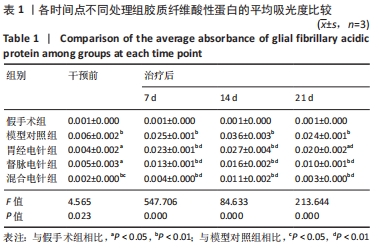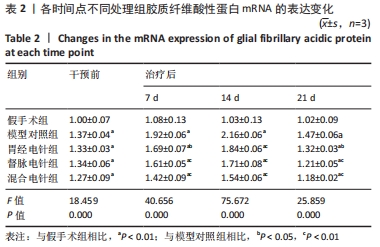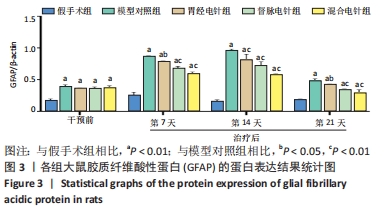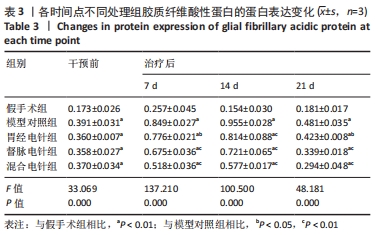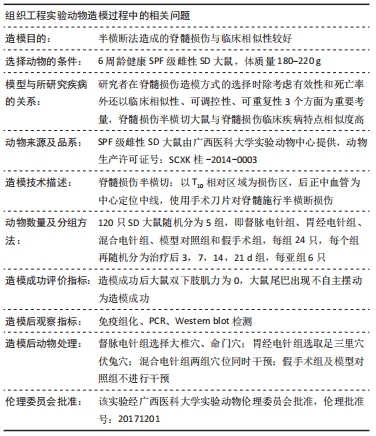中国组织工程研究 ›› 2022, Vol. 26 ›› Issue (26): 4113-4117.doi: 10.12307/2022.811
• 组织构建实验造模 experimental modeling in tissue construction • 上一篇 下一篇
电针刺激对大鼠脊髓损伤部位神经胶质纤维酸性蛋白的影响
唐福宇1,周宾宾2,魏卫兵1,张鸿升3
- 1柳州市中医医院(柳州市壮医医院),广西壮族自治区柳州市 545000;2广西中医药大学第一附属医院,广西壮族自治区南宁市 543000;3广西中医药大学附属瑞康医院,广西壮族自治区南宁市 543000
Effect of electroacupuncture on glial fibrillary acidic protein expression at the injured site in a rat model of spinal cord injury
Tang Fuyu1, Zhou Binbin2, Wei Weibing1, Zhang Hongsheng3
- 1Liuzhou Traditional Chinese Medicine Hospital (Liuzhou Zhuang Medical Hospital), Liuzhou 545000, Guangxi Zhuang Autonomous Region, China; 2the First Affiliated Hospital of Guangxi University of Chinese Medicine, Nanning 543000, Guangxi Zhuang Autonomous Region, China; 3Ruikang Hospital Affiliated to Guangxi University of Chinese Medicine, Nanning 543000, Guangxi Zhuang Autonomous Region, China
摘要:
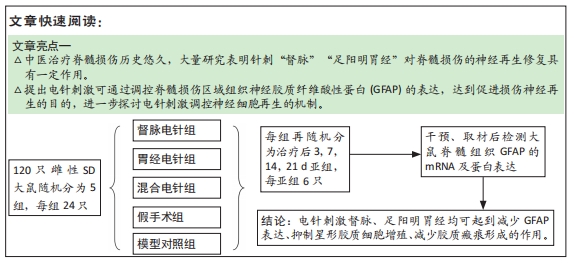
文题释义:
星形胶质细胞:脊髓损伤后星形胶质细胞会增生性地生长,使脊髓在结构形态上保持完整性,同时对神经组织也会起到一定的营养和支持作用。后期,星形胶质细胞持续被激活,分泌或合成抑制性的因子;同时胶质细胞过度增生,会在损伤区形成致密的胶质瘢痕。通过干细胞移植等方法能使轴突有效再生,但是再生的轴突接触到致密的胶质瘢痕时,其轴突的再生就会受到抑制,停止生长。
神经胶质纤维酸性蛋白:与星形胶质细胞的活化程度密切相关,是胶质瘢痕形成的主要标志。当神经胶质纤维酸性蛋白表达下降,胶质瘢痕的形成会受到明显抑制,轴突的芽生会明显增强,这不仅说明神经胶质纤维酸性蛋白对胶质瘢痕的重要性,同时也证实通过抑制神经胶质纤维酸性蛋白的表达能有效缓解胶质瘢痕的形成,对轴突的再生有很好的促进作用。
背景:神经胶质纤维酸性蛋白是一个中间丝过渡表达蛋白,其表达水平是最常用的星形胶质细胞的特异性标志蛋白。中医治疗脊髓损伤历史悠久,大量研究表明针刺“督脉”“足阳明胃经”对脊髓损伤的神经再生修复具有一定作用。
目的:观察电针刺激后脊髓损伤大鼠损伤部位神经胶质纤维酸性蛋白表达的变化,进一步探讨电针刺激对脊髓损伤大鼠神经再生的影响。
方法:将120只SD大鼠随机分为5组,即督脉电针组、胃经电针组、混合电针组、模型对照组和假手术组,每组24只,除假手术组不进行脊髓切断外,其他各组均制备T10脊髓半横断损伤模型。每个组再随机分为治疗后3,7,14,21 d组,每亚组6只。假手术组及模型对照组不进行干预,其他3个电针组进行相应电针干预。以免疫组化法检测损伤局部神经胶质纤维酸性蛋白阳性细胞的表达;PCR、Western blot检测神经胶质纤维酸性蛋白 mRNA及蛋白的表达情况。
结果与结论:①模型对照组损伤后神经胶质纤维酸性蛋白的表达水平呈先增高后降低的趋势,与未损伤的假手术组相比差异有显著性意义(P < 0.05);②督脉电针组、胃经电针组与模型对照组相比,神经胶质纤维酸性蛋白表达水平明显降低(P < 0.05);③混合电针组与督脉电针组、胃经电针组相比神经胶质纤维酸性蛋白表达水平降低,但差异无显著性意义(P > 0.05);④提示电针刺激可降低损伤局部神经胶质纤维酸性蛋白的表达,减少损伤局部星形胶质细胞的表达,从而抑制胶质瘢痕的形成。
缩略语:胶质纤维酸性蛋白:glial fibrillary acidic protein,GFAP
https://orcid.org/0000-0002-4279-371X (唐福宇)
中国组织工程研究杂志出版内容重点:组织构建;骨细胞;软骨细胞;细胞培养;成纤维细胞;血管内皮细胞;骨质疏松;组织工程
中图分类号:
